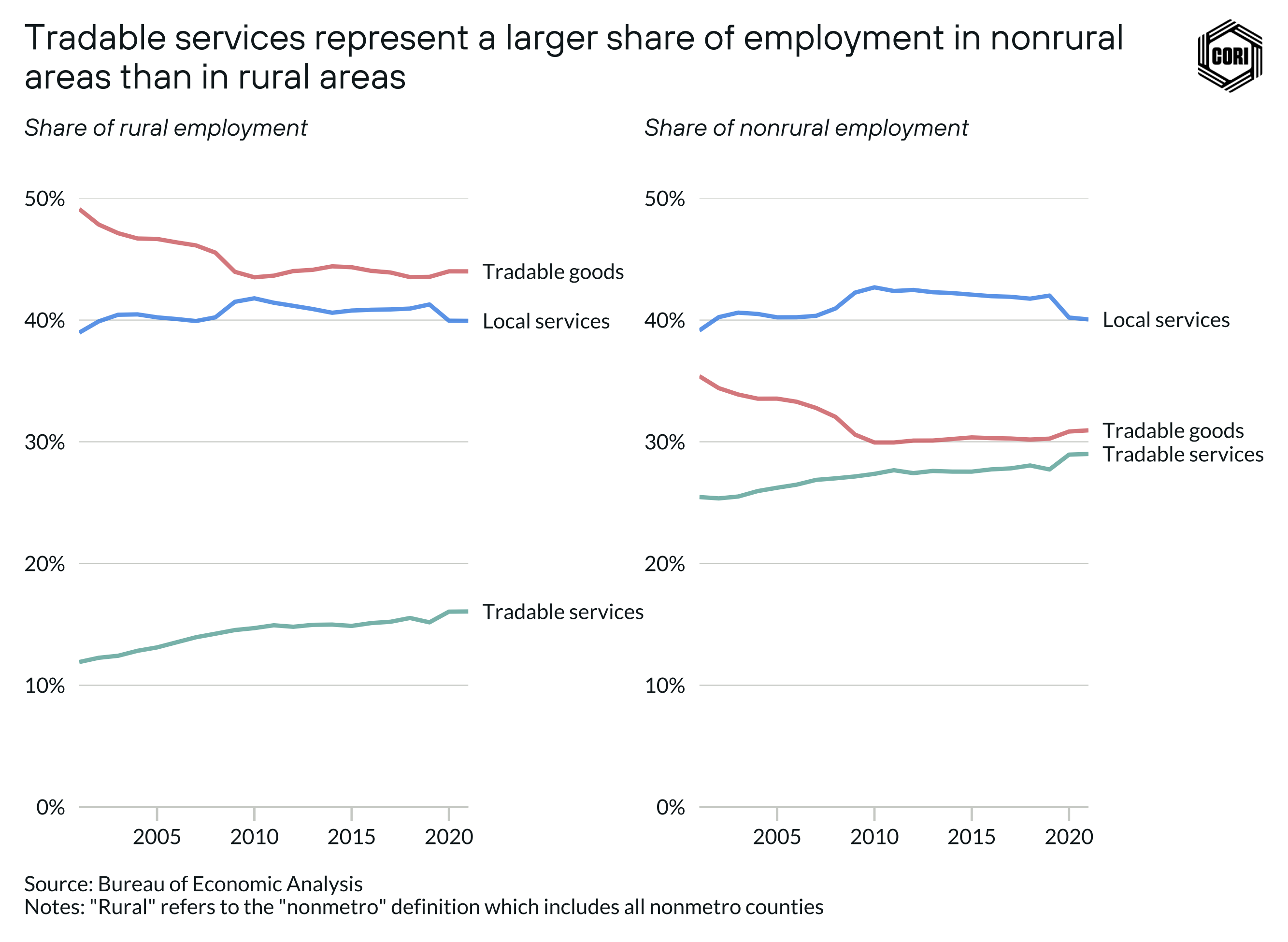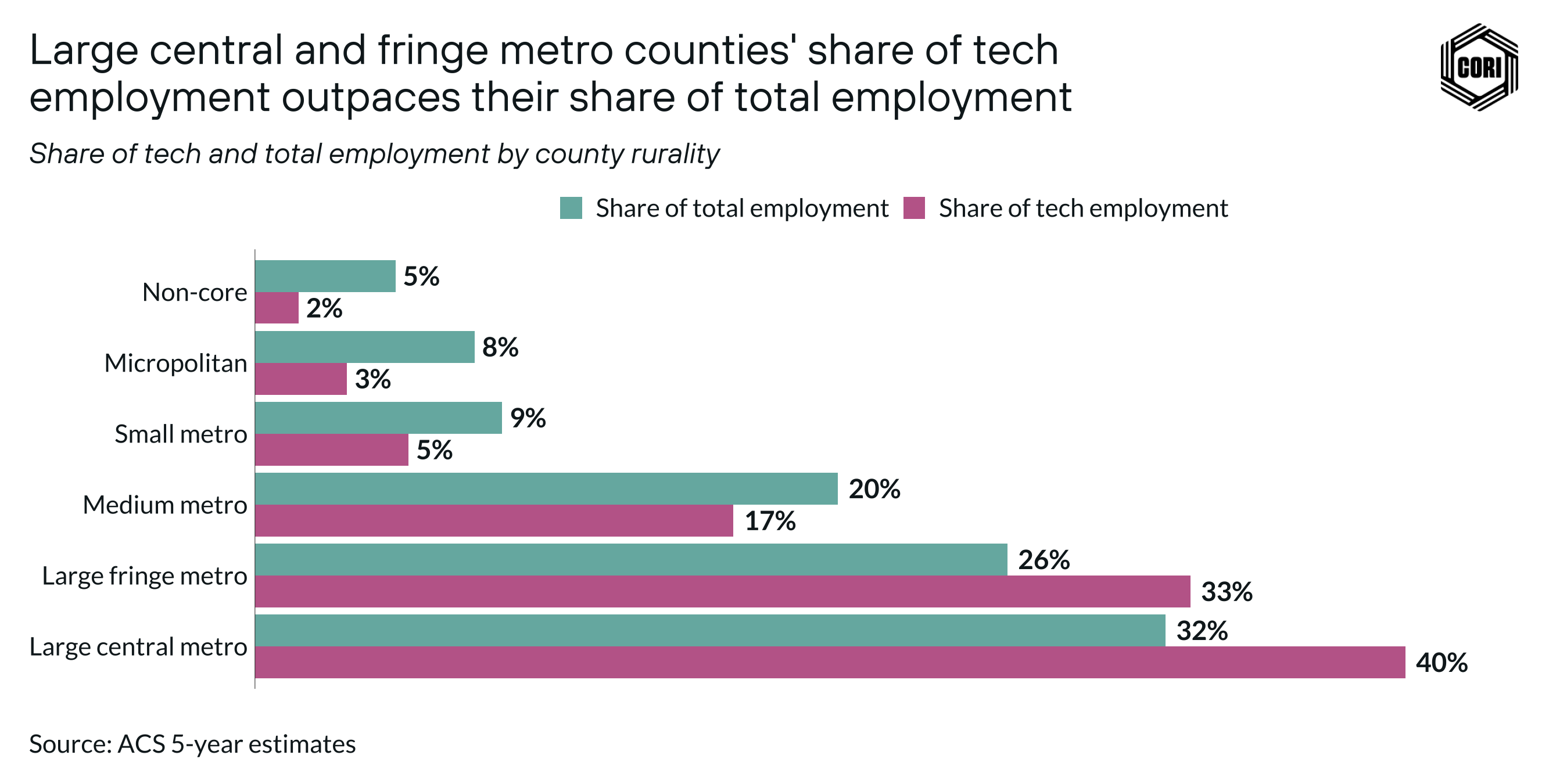Unlocking rural prosperity: The role of tech jobs in equitable development
If we are proactive in building tech opportunities in rural places by investing in core infrastructure, training, and rural startups, we can have more equitable outcomes in this age when the knowledge economy drives so much growth.
In the wake of the tech sector’s rise, there’s a growing movement to harness this momentum for those communities it historically left behind.
These high-paying, knowledge-based roles have the power to transform communities. Unfortunately, access to these jobs, and the community gains that can come with them, remain uneven. Metro areas still hold a disproportionate share of these opportunities.
The use of technology to displace employees — automation — has had an especially negative impact on rural workers (even more so for rural people of color). Historically, rural communities have been exploited for cheap labor, taking advantage of their geographic isolation and a lack of investment. And automation has further endangered the job security and economic opportunities for people who live in rural areas.
But innovation and progress don’t have to be inequitable, and they don’t have to come at the cost of rural places and the people who call these places home. These are choices.
The third story in our Rural Aperture Project, a multi-story series funded by the Robert Wood Johnson Foundation’s Thrive Rural initiative, shows that addressing the growing inequality between rural and nonrural places requires a place-based approach that helps rural areas grow their knowledge economies. By proactively investing in core infrastructure, technology training programs, and rural tech startups, we can foster the growth of tech economies in rural areas. This not only leads to more equitable outcomes in the knowledge economy but also has the potential to improve overall conditions of place — for example, increasing the viability of hospitals with better pay mixes.
Focusing on this work is critical to address the various challenges facing rural communities.
The economic potential of of tradable services and tech jobs in rural America
Today, tradable services — such as banking, finance, consulting, tourism, and technology — have the highest growth potential. These industries provide services that can be sold to customers inside and outside of the local economy bringing wealth and prosperity into rural communities.
Among tradable service occupations, technology jobs offer among the highest earnings (BLS). Tech jobs are among the highest-paid occupations across the United States. Rural areas are no exception: rural workers in computer and math occupations earned an average of $78,843 in 2022 (while the average rural worker earned $48,536 according to 2022 BLS data).
These occupations are projected to have the second-highest growth (behind healthcare support) of all occupation groups in the U.S. from 2021 to 2031 (BLS).
Yet, rural employment is still disproportionately composed of jobs reliant on tradable goods, industries like natural resource extraction, large-scale agriculture, and manufacturing (all sectors that have been more affected by automation). This along with globalization and declining entrepreneurship have widened the gap between rural and nonrural places.
As highlighted by Daniel Immerwahr summarizing the arguments presented in Steven Conn’s latest book, “With so few income sources available, rural people depend heavily on each employer. The opening of a mine, a factory, or a military base might bring flush times, but their closure spells ruin. While cities are, by their [industry] diversity, hedged against economic fluctuations, small towns lie dangerously exposed.”
The disparity between rural and nonrural places widened further with the growth of the knowledge economy as policies and biases concentrated investment elsewhere, limiting rural areas’ ability to diversify their economies by shifting as quickly to tradable services — and making it harder for rural areas to compete (see for example, Pipa & Geismar, 2021). This is especially true for rural communities of color — among the most disadvantaged communities in this country. Overcoming these challenges to help rural areas benefit from the growing tradable services industry demands a place-based approach to build out their tech economies and increase tech startups and tech jobs.
Moreover, the influence of tech jobs (and the tradable services industry) extends beyond just tech workers.
Tech jobs have a multiplier effect — for each tech job created, three to five additional jobs are created in the local economy. These jobs can increase pay in other sectors (Bartik & Sutherland, 2019; Moretti, 2013) because the tech sector supports not only tech-related fields but also other industries that create stable and thriving communities, like local restaurants, entertainment, and cultural activities.
These highly skilled occupations have the ability not only to increase productivity in the places they live, but research shows they help to increase the quality of life in these places as well (Shapiro, 2006). Places lacking innovation and tech industries will simply continue to fall further behind.
An equitable distribution of economic opportunity
Not everyone needs a tech job, but every community needs access to these types of economic opportunities. The tech sector has remained stubbornly concentrated in metro areas and a select few demographic groups (largely white men); it has also become less dynamic over time (O-Brien, 2023).
Access to the new opportunities that tech presents is not uniform, and the barriers can be substantial. Roughly 13% of workers live in rural areas, but rural workers make up only about 5% of the tech workforce (95% of the tech workforce is within nonrural areas). In rural areas, the largest disparity in the geography of tech jobs lies within small towns (micropolitan areas with populations of at least 10,000 but less than 50,000). These small towns also hold the largest untapped potential for tech sector growth.
Tech jobs represent a key driver of rural development and equitable prosperity. They have the potential to bridge economic divides and uplift communities. Achieving this potential requires addressing barriers to access and ensuring that the benefits of tech-driven growth are shared equitably. And economic developers and local leaders play a crucial role in ensuring that the benefits of economic growth are channeled into productive and equitable development.
The pandemic already started to shift the geography of tech employment, and remote work has opened up new possibilities for workers looking to live in rural places. In order to create real wealth with staying power in rural communities, we need to translate these new rural tech workers into opportunities for tech startups that attract investment. If we want a truly dynamic and diverse tech economy, it will require targeted and place-based efforts to develop rural tech ecosystems that can sustain and build economic momentum from these recent trends.
Join us in our commitment to a brighter, more inclusive future for rural America, where innovation and opportunity know no bounds. Stay tuned for our next post, where we dive deeper into how we can break down the barriers holding back rural communities and the strategies for fostering tech job growth in rural areas.
Go deeper
Catch up on previous stories in the Rural Aperture Project, and sign up for our newsletter to ensure you don’t miss future stories and research about rural America.
The Rural Aperture Project
-
Story 1Defining rural America: The consequences of how we count
-
Story 2 — Part IWho lives in rural America? How data shapes (and misshapes) conceptions of diversity in rural America
-
Story 2 — Part IIWho lives in rural America? The geography of rural race and ethnicity
-
Story 3The equity of economic opportunity
-
Blog: The overlooked equity conversationRural America in the tech age


